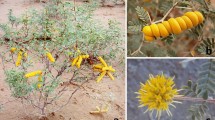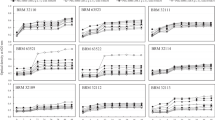Abstract
Aims
Dimethylarsinic acid (DMA), an organic arsenic compound found in rice grain, is a causal agent of straighthead disorder, which can decimate yields. To minimize rice accumulation of DMA, we tested 9 molecules for antagonistic effects with DMA. We also tested whether the source of nitrogen is able to affect DMA uptake, as DMA is a weak acid and different nitrogen sources have differing effects on rhizospheric pH.
Methods
We grew rice (Oryza sativa L. cv. Lemont) hydroponically to maturity in two different experiments. First, 9 potential competitors (boric acid, calcium, glycerol, glycine, lactic acid, phosphoric acid, serine, silicic acid, and urea) were included in the hydroponic solution at a molar ratio ≥ 100:1 competitor:DMA. Second, rice receiving 5 μM DMA was grown under ammonium, nitrate, or a 1:1 mix of ammonium and nitrate. Yield metrics and plant elemental concentrations were measured after harvest.
Results
Of the potential competitors, only silicic acid was able to alleviate straighthead disorder and no competitors were able to reduce grain As by ≥30%. Under differing nitrogen sources, nitrate decreased plant concentrations of As relative to ammonium, but not in the grain.
Conclusions
While Si can alleviate DMA uptake, there remains uncertainty in how most DMA enters the plant.




Similar content being viewed by others
Abbreviations
- DMA:
-
Dimethylarsinic acid
- DCB:
-
Dithionite citrate bicarbonate.
References
Ali W, Isayenkov SV, Zhao F-J, Maathuis FJM (2009) Arsenite transport in plants. Cell Mol Life Sci 66:2329–2339
Bienert GP, Thorsen M, Schussler MD, Nilsson HR, Wagner A, Tamas MJ, Jahn TP (2008) A subgroup of plant aquaporins facilitate the bi-directional diffusion of As(OH)3 and Sb(OH)3 across membranes. BMC Biol 6:26
Brunold C, Rennenberg H (1993) Regulatory interactions between sulfate and nitrate assimilation. In: de Kok LJ, Stulen I, Rennenberg H, Brunold C, Rauser WE (eds) Sulfur nutrition and assimilation in higher plants: regulatory agricultural and environmental aspects. SPB Academic Publishing, The Hague
Bush DS (1995) Calcium regulation in plant cells and its role in signaling. Annu Rev Plant Biol 46:95–122
Choi WG, Roberts DM (2007) Arabidopsis NIP2; 1, a major intrinsic protein transporter of lactic acid induced by anoxic stress. J Biol Chem 282:24209–24218
Danielson JAH, Johanson U (2008) Unexpected complexity of the aquaporin gene family in the moss Physcomitrella patens. BMC Plant Biol 8:45
Dean RM, Rivers RL, Ziedel ML, Roberts DM (1999) Purification and functional reconstitution of soybean nodulin 26: An aquaporin with water and glycerol transport properties. Biochem 38:347–353
Degryse F, Shahbazi A, Verheyen L, Smolders E (2012) Diffusion limitations in root uptake of cadmium and zinc, but not nickel, and resulting bias in the Michaelis constant. Plant Physiol 160:1097–1109
Derry LA, Kurtz AC, Ziegler K, Chadwick OA (2005) Biological control of terrestrial silica cycling and export fluxes to watersheds. Nature 433:728–731
Dettenmaier EM, Doucette WJ, Bugbee B (2009) Chemical hydrophobicity and uptake by plant roots. Environ Sci Technol 43:324–329
Fischer W-N, Andre B, Rentsch D, Krolkiewicz S, Tegeder M, Breitkreuz K, Frommer WB (1998) Amino acid transport in plants. Trends Plant Sci 3:188–195
Hawkesford MJ, Davidian J-C, Grignon C (1993) Sulphate/proton cotransport in plasma-membrane vesicles isolated from roots of Brassica napus L.: increased transport in membranes isolated from sulphur-starved plants. Planta 190:297–304
He Z, Yan H, Chen Y, Shen H, Xu W, Zhang H, Shi L, Zhu Y-G, Ma M (2016) An aquaporin PvTIP4;1 from Pteris vittata may mediate arsenite uptake. New Phytol 209:746–761
Jackson BP (2015) Fast ion chromatography-ICP-QQQ for arsenic speciation. J Anal At Spectrom 30:1405–1407
Jenny H (1966) Pathways of ions from soil into root according to diffusion models. Plant Soil 25:265–289
Jeong BR, Lee CW (1996) Influence of ammonium, nitrate, and chloride on solution pH and ion uptake by ageratum and salvia in hydroponic culture. J Plant Nutr 19:1343–1360
Koprivova A, Suter M, den Camp RO, Brunold C, Kopriva S (2000) Regulation of sulfate assimilation by nitrogen in Arabidopsis. Plant Physiol 122:737–746
Kraska JE, Breitenbeck GA (2010) Simple, robust method for quantifying silicon in plant tissue. Commun Soil Sci Plant Anal 41:2075–2085
Kubachka KM, Shockey NV, Hanley TA, Conklin SD, Heitkemper DT (2012) EAM 4.11: arsenic speciation in rice and rice products using high performance liquid chromatography inductively coupled plasma-mass spectrometric determination. U.S. Food and Drug Administration, White Oak
Lafferty BJ, Loeppert RH (2005) Methyl arsenic adsorption and desorption behavior on iron oxides. Environ Sci Technol 39:2120–2127
Li RY, Ago Y, Liu WJ, Mitani N, Feldmann J, McGrath SP, Ma JF, Zhao FJ (2009) The rice aquaporin Lsi1 mediates uptake of methylated arsenic species. Plant Physiol 150:2071–2080
Limmer MA, Burken JG (2014) Plant translocation of organic compounds: molecular and physicochemical predictors. Environ Sci Technol Lett 1:156–161
Limmer MA, Wise P, Dykes GE, Seyfferth AL (2018) Silicon decreases dimethylarsinic acid concentration in rice grain and mitigates straighthead disorder. Environ Sci Technol 52:4809–4816
Ma JF, Yamaji N, Mitani N, Xu XY, Su YH, McGrath SP, Zhao FJ (2008) Transporters of arsenite in rice and their role in arsenic accumulation in rice grain. Proc Natl Acad Sci U S A 105:9931–9935
Marin AR, Masscheleyn PH, Patrick WH Jr (1992) The influence of chemical form and concentration of arsenic on rice growth and tissue arsenic concentration. Plant Soil 139:175–183
Marschner H (2011) Marschner's mineral nutrition of higher plants. Academic press, Cambridge
Meharg AA, Jardine L (2002) Arsenite transport into paddy rice (Oryza sativa) roots. New Phytol 157:39–44
Mishra S, Mattusch J, Wennrich R (2017) Accumulation and transformation of inorganic and organic arsenic in rice and role of thiol-complexation to restrict their translocation to shoot. Sci Rep 7: 40522
Mosa KA, Kumar K, Chhikara S, Mcdermott J, Liu Z, Musante C, White JC, Dhankher OM (2012) Members of rice plasma membrane intrinsic proteins subfamily are involved in arsenite permeability and tolerance in plants. Transgenic Res 21:1265–1277
Nason SL, Miller EL, Karthikeyan K, Pedersen JA (2018) Plant-induced changes to rhizosphere pH impact leaf accumulation of lamotrigine but not carbamazepine. Environ Sci Technol Lett 5:377–381
Raab A, Williams PN, Meharg A, Feldmann J (2007) Uptake and translocation of inorganic and methylated arsenic species by plants. Environ Chem 4:197–203
Rahman A, Mostofa MG, Alam MM, Nahar K, Hasanuzzaman M, Fujita M (2015) Calcium mitigates arsenic toxicity in rice seedlings by reducing arsenic uptake and modulating the antioxidant defense and glyoxalase systems and stress markers. Biomed Res Int. 2015: 340812
Sakurai J, Ahamed A, Murai M, Maeshima M, Uemura M (2008) Tissue and cell-specific localization of Rice Aquaporins and their water transport activities. Plant Cell Physiol 49:30–39
Seyfferth AL, Morris AH, Gill R, Kearns KA, Mann JN, Paukett M, Leskanic C (2016) Soil incorporation of silica-rich rice husk decreases inorganic arsenic in Rice grain. J Agric Food Chem 64:3760–3766
Seyfferth AL, Limmer MA, Dykes GE (2018) On the use of silicon as an agronomic mitigation strategy to decrease arsenic uptake by rice. Adv Agron 149:49–91
Takano J, Wada M, Ludewig U, Schaaf G (2006) The Arabidopsis major intrinsic protein NIP5; 1 is essential for efficient boron uptake and plant development under boron limitation. Plant Cell 18:1498–1509
Taylor GJ, Crowder AA (1983) Use of the DCB technique for extraction of hydrous iron oxides from roots of wetland plants. Am J Bot 70:1254–1257
Teasley WA, Limmer MA, Seyfferth AL (2017) How rice (Oryza sativa L.) responds to elevated as under different Si-rich soil amendments. Environ Sci Technol 51:10335–10343
Trapp S (2000) Modelling uptake into roots and subsequent translocation of neutral and ionisable organic compounds. Pest Manag Sci 56:767–778
Wallace IS, Roberts DM (2005) Distinct transport selectivity of two structural subclasses of the nodulin-like intrinsic protein family of plant aquaglyceroporin channels. Biochem 44:16826–16834
Wallace IS, Choi W-G, Roberts DM (2006) The structure, function and regulation of the nodulin 26-like intrinsic protein family of plant aquaglyceroporins. Biochem Biophys Acta – Biomembranes 1758:1165–1175
Wang X, Ma LQ, Rathinasabapathi B, Liu Y, Zeng G (2010) Uptake and translocation of arsenite and arsenate by Pteris vittata L.: effects of silicon, boron and mercury. Environ Exp Bot 68:222–229
White PJ (2001) The pathways of calcium movement to the xylem. J Exp Bot 52:891–899
White PJ, Broadley MR (2003) Calcium in plants. Ann Bot 92:487–511
Zavala YJ, Duxbury JM (2008) Arsenic in Rice I. estimating normal levels of total arsenic in rice grain. Environ Sci Technol 42:3856–3860
Zhang H, Selim HM (2008) Reaction and transport of arsenic in soils: equilibrium and kinetic modeling. Adv Agron 98:45–115
Zhao FJ, Zhu YG, Meharg AA (2013) Methylated arsenic species in rice: geographical variation, origin, and uptake mechanisms. Environ Sci Technol 47:3957–3966
Zheng MZ, Li G, Sun GX, Shim H, Cai C (2013) Differential toxicity and accumulation of inorganic and methylated arsenic in rice. Plant Soil 365:227–238
Acknowledgements
M.A.L. acknowledges support from National Institute of Food and Agriculture, U.S. Department of Agriculture, under award number 2016-67012-24673. The authors also thank Ayofela Dare and Julia O’Brien for assistance with hydroponic work and Caroline Golt and the UD Soil Testing Laboratory for assistance with ICP analysis.
Author information
Authors and Affiliations
Corresponding author
Additional information
Responsible Editor: Honghua He.
Publisher’s note
Springer Nature remains neutral with regard to jurisdictional claims in published maps and institutional affiliations.
Electronic supplementary material
ESM 1
(DOCX 5895 kb)
Rights and permissions
About this article
Cite this article
Limmer, M.A., Seyfferth, A.L. The role of small molecules in restricting rice accumulation of dimethylarsinic acid. Plant Soil 447, 599–609 (2020). https://doi.org/10.1007/s11104-019-04414-1
Received:
Accepted:
Published:
Issue Date:
DOI: https://doi.org/10.1007/s11104-019-04414-1




